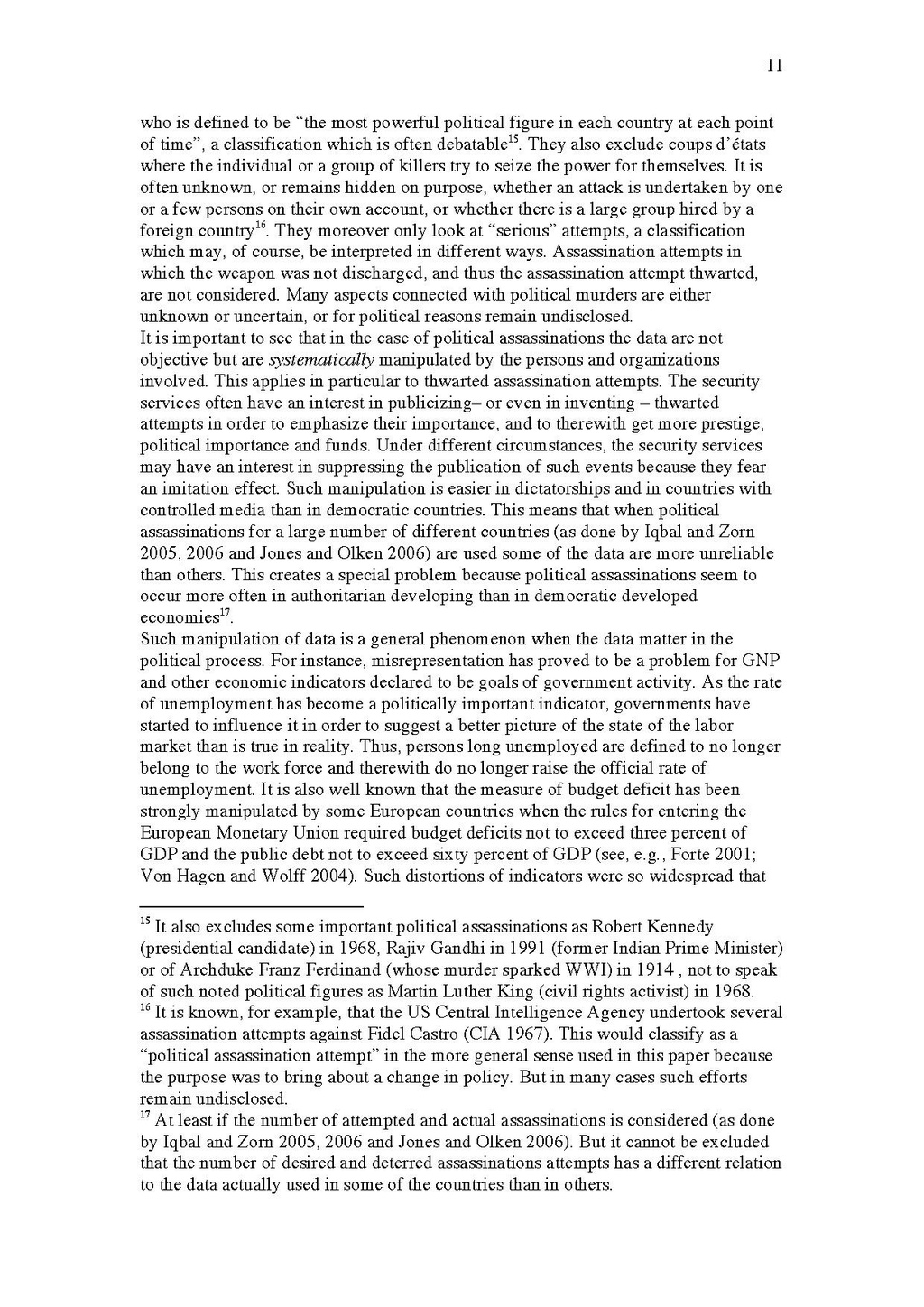who is defined to be “the most powerfUL political figure in each country at each point
of time”, a classification which is often debatable15. They also exclude coups d’états
where the individual or a group of killers try to seize the power for themselves. It is
often unknown, or remains hidden on purpose, whether an attack is undertaken by one
or a few persons on their own account, or whether there is a large group hired by a
foreign country16. They moreover only look at “serious” attempts, a classification
which may, of course, be interpreted in different ways. Assassination attempts in
which the weapon was not discharged, and thus the assassination attempt thwarted,
are not considered. Many aspects connected with political murders are either
unknown or uncertain, or for political reasons remain undisclosed.
It is important to see that in the case of political assassinations the data are not
objective but are systematically manipulated by the persons and organizations
involved. This applies in particular to thwarted assassination attempts. The security
services often have an interest in publicizing– or even in inventing – thwarted
attempts in order to emphasize their importance, and to therewith get more prestige,
political importance and funds. Under different circumstances, the security services
may have an interest in suppressing the publication of such events because they fear
an imitation effect. Such manipulation is easier in dictatorships and in countries with
controlled media than in democratic countries. This means that when political
assassinations for a large number of different countries (as done by Iqbal and Zorn
2005, 2006 and Jones and Olken 2006) are used some of the data are more unreliable
than others. This creates a special problem because political assassinations seem to
occur more often in authoritarian developing than in democratic developed
economies17.
Such manipulation of data is a general phenomenon when the data matter in the
political process. For instance, misrepresentation has proved to be a problem for GNP
and other economic indicators declared to be goals of government activity. As the rate
of unemployment has become a politically important indicator, governments have
started to influence it in order to suggest a better picture of the state of the labor
market than is true in reality. Thus, persons long unemployed are defined to no longer
belong to the work force and therewith do no longer raise the official rate of
unemployment. It is also well known that the measure of budget deficit has been
strongly manipulated by some European countries when the rules for entering the
European Monetary Union required budget deficits not to exceed three percent of
GDP and the public debt not to exceed sixty percent of GDP (see, e.g., Forte 2001;
Von Hagen and Wolff 2004). Such distortions of indicators were so widespread that
15 It also excludes some important political assassinations as Robert Kennedy
(presidential candidate) in 1968, Rajiv Gandhi in 1991 (former Indian Prime Minister)
or of Archduke Franz Ferdinand (whose murder sparked WWI) in 1914 , not to speak
of such noted political figures as Martin Luther King (civil rights activist) in 1968.
16 It is known, for example, that the US Central Intelligence Agency undertook several
assassination attempts against Fidel Castro (CIA 1967). This would classify as a
“political assassination attempt” in the more general sense used in this paper because
the purpose was to bring about a change in policy. But in many cases such efforts
remain undisclosed.
17 At least if the number of attempted and actual assassinations is considered (as done
by Iqbal and Zorn 2005, 2006 and Jones and Olken 2006). But it cannot be excluded
that the number of desired and deterred assassinations attempts has a different relation
to the data actually used in some of the countries than in others.
